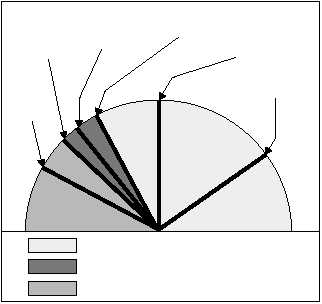originally stable may become unstable due to moisture
distribution if the entire layer is lifted.
Convective stability is the condition that occurs
when the equilibrium of a layer of air, because of the
temperature and humidity distribution, is such that
when the entire layer is lifted, its stability is increased
(becomes more stable).
Convective
instability
is
the
condition
of
equilibrium of a layer of air occurring when the
temperature and humidity distribution is such that when
the entire layer of air is lifted, its instability is increased
(becomes more unstable).
CONVECTIVE STABILITY.—Consider a layer
of air whose humidity distribution is dry at the bottom
and moist at the top. If the layer of air is lifted, the top
and the bottom cool at the same rate until the top
reaches saturation. Thereafter, the top cools at a slower
rate of speed than the bottom. The top cools saturation
adiabatically (.55°C/100 meters), while the bottom
continues to cool dry adiabatically (1°C/100 meters).
The lapse rate of the layer then decreases; hence, the
stability increases. The layer must be initially unstable
and may become stable when lifting takes place.
CONVECTIVE INSTABILITY.—Consider a
layer of air in which the air at the bottom is moist and
the air at the top of the layer is dry. If this layer of air is
lifted, the bottom and the top cool dry adiabatically
until the lower portion is saturated. The lower part then
cools saturation adiabatically while the top of the layer
is still cooling dry adiabatically. The lapse rate then
begins to increase and instability increases.
To determine the convective stability or instability
of a layer of air, you should first know why you expect
the lifting of a whole layer. The obvious answer is an
orographic barrier or a frontal surface. Next, determine
how much lifting is to be expected and at what level it
commences. Lifting of a layer of air close to the surface
of the Earth is not necessary. The amount of lifting, of
course, depends on the situation at hand. Figure 2-15
illustrates the varying degrees of air stability that are
directly related to the rate at which the temperature
changes with height.
Determining Bases of Convective Type Clouds
You have seen from our foregoing discussion that
moisture is important in determining certain stability
conditions in the atmosphere. You know, too, that the
difference between the temperature and the dew point is
an indication of the relative humidity. When the dew
point and the temperature are the same, the air is
saturated and some form of condensation cloud may be
expected. This lends itself to a means of estimating the
height of the base of clouds formed by surface heating
when the surface temperature and dew point are known.
You know that the dew point decreases in temperature
at the rate of 1°F per 1,000 feet during a lifting process.
The ascending parcel in the convective current
experiences a decrease in temperature of about 5 1/2°F
per 1,000 feet. Thus the dew point and the temperature
approach each other at the rate of 4 1/2°F per 1,000 feet.
As an example, consider the surface temperature to be
80°F and the surface dew point 62°F, a difference of
18°F. This difference, divided by the approximate rate
the temperature approaches the dew point (4 1/2°F per
1,000 ft) indicates the approximate height of the base of
the clouds caused by this lifting process (18 ÷ 4 1/2) ×
2-21
AG5f0215
STABLE
CONDITIONALLY UNSTABLE
UNSTABLE
NORMAL
LAPSE
RATE
MOIST
ADIABATIC
ADIABATIC
ISOTHERMAL
SUPER
ADIABATIC
INVERSION
Figure 2-15.—Degrees of stability in relation to temperature
changes with height.


